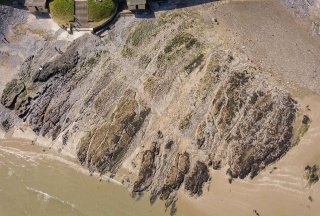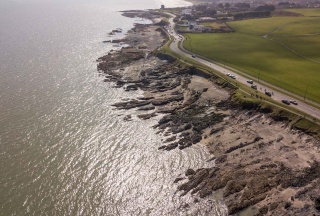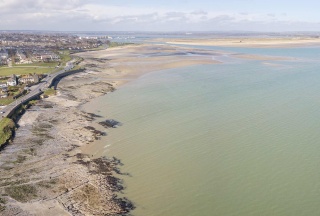Geology
Introduction
Ireland has a long and exciting geological history. The Iapetus Ocean once divided what is now Ireland and its closure caused volcanoes, earthquakes and new mountains. We moved over millions of years from the southern hemisphere through desert and tropical environments to our current position.
Volcanoes & Coral Reefs

From Portmarnock you can see rocks from three Geological Periods; Cambrian (541 – 485 million years), Ordovician (485 – 444 Ma) and Carboniferous (359 – 299 Ma). Ireland’s Eye and Howth are Cambrian in age and are from a time when only simple life forms existed. The rocks are mainly sandstone and were formed in the Iapetus Ocean. Lambay Island is Ordovician in age and volcanic in origin from the closure of the Iapetus Ocean. Finally, the inclined beds of rock on the shore are Carboniferous in age and formed when Ireland was in the tropics and covered periodically by warm shallow seas. It is possible to find fossils of marine species such as corals, crinoids and brachiopods in these beds. If you look south on a clear day, you should be able to see Sugar Loaf mountain in Co. Wicklow. It is metamorphic sandstone (quartzite) and is a similar age to Howth Head and Ireland’s Eye.
Folded Rocks

The layers or beds of rock on the shore were formed in the Carboniferous Period (359 – 299 million years ago) when Ireland was in the tropics and was covered by a warm shallow sea. They are mainly limestone but there are some fine beds of shale and sandstone also.
Tropical Seas

The environment was much like the Bahamas or the Great Barrier Reef in Australia today and reef systems developed. It is possible to see fossils of marine organisms in the rocks. The most common type is a colonial coral called lithostrotion. Corals provided the framework for the reef system and provided shelter for other organisms such as brachiopods. The beds have a shallow dip and it is possible to see the uneven beds caused by the reefs and muds when looking at a section of beds together.
Lambay Island is much older and is volcanic in origin. The rocks are the result of the closure of the Iapetus Ocean in the Ordovician Period.